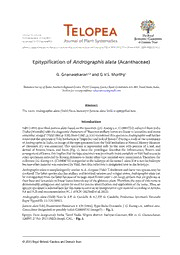
Epitypification of Andrographis alata (Acanthaceae) PDF
Preview Epitypification of Andrographis alata (Acanthaceae)
Telopea Volume 18: 165-166 The Royal Publication date: 23 July 2015 Botanic Gardens Journal of Plant Systematics dx.doi.org/10.7751/telopea8903 & Domain Trust plantnet.rbgsyd.nsw.gov.au/Telopea • escholarship.usyd.edu.au/journals/index.php/TEL • ISSN 0312-9764 (Print) • ISSN 2200-4025 (Online) Epitypification of Andrographis alata (Acanthaceae) G. Gnanasekaran and G.V.S. Murthy 12 1 botanical Survey of India, Southern Regional Centre, TNAU Campus, Lawley Road, Coimbatore 641 003, Tamil Nadu, India. 2Author for correspondence: [email protected] Abstract The name Andrographis alata (Vahl) Nees, basionym Justicia alata Vahl, is epitypified here. Introduction Vahl (1804) described Justicia alata based on the specimen (/.G. Koenig s.n., C10004732) collected from India [India Orientalis] with the diagnostic characters of “Racemes axillary, leaves are linear to lanceolate and stems somewhat winged” (Vahl 1804, p. 139). Nees (1847, p. 516) transferred this species to Andrographis and further stated that the specimen at Vahl herbarium is “imperfect and lack of flowers”. During a study of the systematics of Andrographis in India, an image of the type specimen from the Vahl herbarium at Natural History Museum of Denmark (C) was examined. This specimen is represented only by the stem with portion of a leaf, and devoid of flowers, bracts, and fruits (Fig. 1). Since the protologue describes the inflorescence, flowers and arrangement of leaves, this implies that the type specimen was previously more complete or Vahl had access to other specimens collected by Koenig. Attempts to locate other type material were unsuccessful. Therefore, the collection J.G. Koenig s.n. (C10004732) is regarded as the holotype of the name /. alata. If it is not the holotype because other material was examined by Vahl, then this collection is designated here as the lectotype. Andrographis alata is morphologically similar to A. elongata (Vahl) T.Anderson and these two species may be confused. The latter species also has axillary and terminal racemes and winged stems. Andrographis alata can be distinguished from the latter because of its large-sized flower (over 1 cm long), anthers that are glabrous at their base and lanceolate to linear leaves towards top of the glabrous plant. Therefore, the type of this name is demonstrably ambiguous and cannot be used for precise identification and application of the name. Thus, an epitype specimen is selected here for this name to serve as an interpretative type material according to Articles 9.8 and 9.21 and recommendation 9C.1 of ICN (McNeill et al. 2012). Andrographis alata (Vahl) Nees in A.R de Candolle & A.L.RR de Candolle, Prodromus Systematis Naturalis Regni Vegetabilis 11: 516 (1847). Justicia alata Vahl, Enumeratio Plantarum 1: 139 (1804). Type: India Orientalis: /. G. Koenig s.n., without date. (Lecto, here designated, or possibly holo): C10004732 [image]!). - Fig. 1. Epitype (here designated): India: Tamil Nadu: Nilgiris district: Barliyar-Coonoor, 800 m, G. Gnanasekaran 126893,27 Feb 2013 (MH); isoepi: CAL. - Fig. 2. © 2015 Royal Botanic Gardens and Domain Trust 166 Telopea 18: 165-166, 2015 Gnanasekaran and Murthy ¥ *(cid:9632) J" (cid:9632) »! ilbTk? |jp, Ini AXlx f/J- sr^jt... Fig. 1: Lectotype (or perhaps Holotype) of Fig. 2: Epitype of Andrographis alata (basionym = Justicia alata) Andrographis alata (basionym = Justicia alata) Acknowledgments Authors are grateful to Director, BSI, for facilities and thankful to the curator and Dr lb Friis, Professor of Natural History Museum of Denmark (C) for making available to us the image of the type specimen. They are also thankful to Drs K.N. Gandhi, Sr. Nomenclatural Registrar, HUH, Cambridge, V.J. Nair, Editing Consultant, BSI, SRC, Coimbatore and W. Arisdason, Scientist, BSI, Kolkata, for critical comments on the manuscript. Authors are also thankful to Dr Barry J Conn (NSW) for his valuable suggestions. References McNeill J, Barrie FR, Buck WR, Demoulin V, Greuter W, Hawksworth DL, Herendeen PS, Knapp S, Marhold K, Prado J, Prud’homme van Reine WF, Smith GF, Wiersema JH, Turland NJ (2012). International Code of Nomenclature for algae, fungi, and plants (Melbourne Code). Adopted by the Eighteenth International Botanical Congress Melbourne, Australia, July 2011, A.R.G. Gantner Verlag KG. [Regnum Veg. 154] Nees von Esenbeck CGD (1847). Acanthaceae. pp. 223-247. In: Candolle AP de, Candolle ALPP de (eds.), Prodromus Systematis Naturalis Regni VegetabilisVol. 11. Treuttel & Wurtz, Paris. Vahl M (1804). Enumeratio Plantarum Vol. 1. N. Molleri & Filii, Copenhagen, p. 139 Manuscript received 9 July 2015, accepted 14 July 2015
